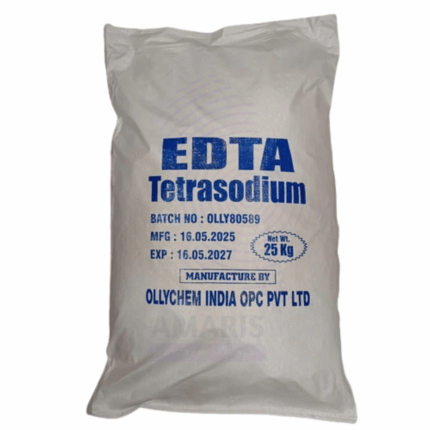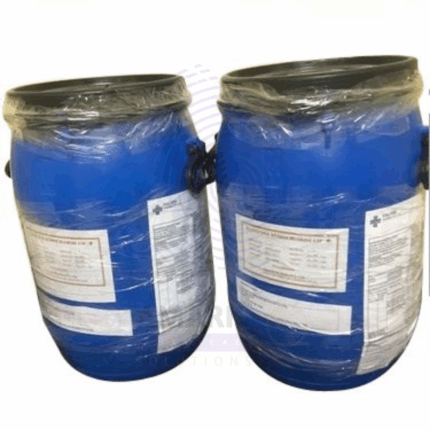Ellagic Acid
Ellagic Acid is a naturally occurring polyphenolic compound found in numerous fruits, nuts, and vegetables such as pomegranates, strawberries, raspberries, walnuts, and cranberries. It is a potent antioxidant known for its ability to scavenge free radicals and chelate metal ions. Due to its significant anti-inflammatory, anti-carcinogenic, and anti-viral properties, Ellagic Acid has gained extensive interest in pharmaceutical, nutraceutical, cosmetic, and food industries. It appears as a yellow to light brown crystalline powder, insoluble in water but soluble in organic solvents like ethanol and DMSO.
Ellagic Acid Uses
Primary Uses
- Pharmaceuticals & Nutraceuticals
- Utilized as an active ingredient for its antioxidant and anti-inflammatory effects.
- Employed in formulations aimed at cancer prevention and as adjunct therapy due to its anti-proliferative properties.
- Investigated for potential antiviral applications including HIV and herpes simplex viruses.
- Used in dietary supplements for general health and immune support.
- Cosmetics & Personal Care
- Incorporated in anti-aging skin care products for its ability to protect skin from oxidative damage and UV-induced aging.
- Used in formulations targeting hyperpigmentation and skin brightening due to its melanin synthesis inhibition.
- Acts as an anti-inflammatory agent soothing irritated or sensitive skin.
- Food Industry
- Applied as a natural antioxidant additive in food preservation to extend shelf life and prevent lipid peroxidation.
- Used as a functional ingredient in health foods, beverages, and supplements.
- Research & Analytical Uses
- Used in biochemical research to study antioxidant mechanisms and as a standard compound in polyphenol analysis.
Secondary Uses
- Agriculture
- Explored as a natural plant growth regulator and for potential pest resistance due to its antimicrobial properties.
- Biomedical Research
Investigated in tissue engineering and regenerative medicine for its cell-protective effects.
- Basic Identification Attributes
- Chemical Name (IUPAC): 2,3,7,8-Tetrahydroxy-[1]benzopyrano[5,4,3-cde][1]benzopyran-5,10-dione
- Common/Trade Name: Ellagic Acid
- CAS Number: 476-66-4
- HS Code: 2934.99.99
- Molecular Formula: C₁₄H₆O₈
- Synonyms:
- 4,4',5,5',6,6'-Hexahydroxydiphenic acid dilactone
- 2,3,7,8-Tetrahydroxychromeno[5,4,3-cde]chromene-5,10-dione
- Physical & Chemical Properties
- Physical State: Crystalline powder
- Color & Odor: Yellow to light brown; odorless
- Melting Point: Approximately 300°C (decomposes)
- Solubility: Insoluble in water; soluble in ethanol, methanol, DMSO, and alkaline solutions
- Stability: Stable under normal conditions; sensitive to strong acids and bases
- Safety & Hazard Attributes
- Hazard Class (GHS): Not classified as hazardous
- Toxicity: Low toxicity; generally safe in topical and oral use at recommended doses
- Exposure Limits: Not established
- Storage & Handling Attributes
- Storage Conditions: Store in cool, dry, dark place in tightly sealed containers
- Container Type: Glass or plastic bottles with airtight caps
- Shelf Life: 2–3 years if stored properly
- Handling Precautions: Avoid dust inhalation and prolonged skin contact
- Regulatory & Compliance Attributes
- Approved as a dietary supplement ingredient in many regions
- Compliant with food safety and cosmetic regulations globally
- Environmental & Health Impact
- Biodegradability: Biodegradable under environmental conditions
- Ecotoxicity: Low
- Bioaccumulation: Not expected
Carcinogenicity/Mutagenicity: Not classified as carcinogenic or mutagenic
Safety Handling Precautions
PPE Required:
- Dust mask or respirator (for powder handling)
- Safety goggles
- Gloves (nitrile or latex)
- Protective clothing or lab coat
Handling Guidelines:
- Handle in well-ventilated areas
- Avoid dust generation and inhalation
- Avoid prolonged skin contact
- Use closed systems or local exhaust ventilation when available
Storage Measures:
- Keep container tightly closed
- Store away from strong oxidizers and bases
- Protect from light and moisture
Hygiene Practices:
- Wash hands after handling
- Do not eat, drink, or smoke in handling areas
- Clean spills promptly to avoid dust spread
First Aid Measures
- Inhalation: Move to fresh air; seek medical attention if irritation persists
- Skin Contact: Wash thoroughly with soap and water; seek medical attention if irritation develops
- Eye Contact: Rinse with plenty of water for 15 minutes; seek medical advice if irritation persists
- Ingestion: Rinse mouth; not expected to be toxic, but seek medical attention if large amounts ingested
Firefighting Measures
- Fire Hazards: Non-flammable
- Extinguishing Media: Water spray, foam, dry chemical, or carbon dioxide
- Special Precautions: Use standard protective equipment
Decomposition Products: May emit carbon monoxide, carbon dioxide, and other organic vapors upon decomposition


 Preservatives(food)
Preservatives(food) Flavor Enhancers
Flavor Enhancers Acidulants
Acidulants Sweeteners
Sweeteners Antioxidants
Antioxidants Colorants(food)
Colorants(food) Nutraceutical Ingredients (food)
Nutraceutical Ingredients (food) Nutrient Supplements
Nutrient Supplements Emulsifiers
Emulsifiers
 Collectors
Collectors Dust Suppressants
Dust Suppressants Explosives and Blasting Agents
Explosives and Blasting Agents Flocculants and Coagulants
Flocculants and Coagulants Frothers
Frothers Leaching Agents
Leaching Agents pH Modifiers
pH Modifiers Precious Metal Extraction Agents
Precious Metal Extraction Agents
 Antioxidants(plastic)
Antioxidants(plastic) Colorants (Pigments, Dyes)
Colorants (Pigments, Dyes) Fillers and Reinforcements
Fillers and Reinforcements Flame Retardants
Flame Retardants Monomers
Monomers Plasticizers
Plasticizers Polymerization Initiators
Polymerization Initiators Stabilizers (UV, Heat)
Stabilizers (UV, Heat)
 Antifoaming Agents
Antifoaming Agents Chelating Agents
Chelating Agents Coagulants and Flocculants
Coagulants and Flocculants Corrosion Inhibitors
Corrosion Inhibitors Disinfectants and Biocides
Disinfectants and Biocides Oxidizing Agents
Oxidizing Agents pH Adjusters
pH Adjusters Scale Inhibitors( water)
Scale Inhibitors( water)
 Antioxidants(cosmetic)
Antioxidants(cosmetic) Emollients
Emollients Fragrances and Essential Oils
Fragrances and Essential Oils Humectants
Humectants Preservatives
Preservatives Surfactants(cosmetic)
Surfactants(cosmetic) Thickeners
Thickeners UV Filters
UV Filters
 Fertilizers
Fertilizers Soil Conditioners
Soil Conditioners Plant Growth Regulators
Plant Growth Regulators Animal Feed Additives
Animal Feed Additives Biostimulants
Biostimulants Pesticides (Herbicides, Insecticides, Fungicides)
Pesticides (Herbicides, Insecticides, Fungicides)
 Active Pharmaceutical Ingredients (APIs)
Active Pharmaceutical Ingredients (APIs) Excipients
Excipients Solvents(pharmaceutical)
Solvents(pharmaceutical) Antibiotics
Antibiotics Antiseptics and Disinfectants
Antiseptics and Disinfectants Vaccine Adjuvants
Vaccine Adjuvants Nutraceutical Ingredients (pharmaceutical)
Nutraceutical Ingredients (pharmaceutical) Analgesics & Antipyretics
Analgesics & Antipyretics
 Analytical Reagents
Analytical Reagents Solvents(lab)
Solvents(lab) Chromatography Chemicals
Chromatography Chemicals Spectroscopy Reagents
Spectroscopy Reagents microbiology-and-cell-culture-reagents
microbiology-and-cell-culture-reagents Molecular Biology Reagents
Molecular Biology Reagents Biochemical Reagents
Biochemical Reagents Inorganic and Organic Standards
Inorganic and Organic Standards Laboratory Safety Chemicals
Laboratory Safety Chemicals Specialty Laboratory Chemicals(Special Laboratory Equipment)
Specialty Laboratory Chemicals(Special Laboratory Equipment)
 Demulsifiers
Demulsifiers Hydraulic Fracturing Fluids
Hydraulic Fracturing Fluids Scale Inhibitors(oil)
Scale Inhibitors(oil) Surfactants(oil)
Surfactants(oil) Drilling Fluids
Drilling Fluids
 Dyes and Pigments
Dyes and Pigments Bleaching Agents
Bleaching Agents Softening Agents
Softening Agents Finishing Agents
Finishing Agents Antistatic Agents
Antistatic Agents
 Admixtures
Admixtures Waterproofing Agents
Waterproofing Agents Sealants and Adhesives
Sealants and Adhesives Curing Compounds
Curing Compounds Concrete Repair Chemicals
Concrete Repair Chemicals Anti-Corrosion Coatings
Anti-Corrosion Coatings
 Surfactants(cleaning)
Surfactants(cleaning) Builders
Builders Enzymes
Enzymes Solvents (Cleaning)
Solvents (Cleaning) Fragrances
Fragrances
 Electronic Chemicals
Electronic Chemicals Catalysts
Catalysts Lubricants
Lubricants Photographic Chemicals
Photographic Chemicals Refrigerants
Refrigerants Automotive chemicals
Automotive chemicals Pyrotechnic Chemicals
Pyrotechnic Chemicals
 Biodegradable Surfactants
Biodegradable Surfactants Bio-based Solvents
Bio-based Solvents Renewable Polymers
Renewable Polymers Carbon Capture Chemicals
Carbon Capture Chemicals Wastewater Treatment Chemicals
Wastewater Treatment Chemicals
 Pigments
Pigments Solvents(paint)
Solvents(paint) Specialty Coatings
Specialty Coatings Binders/Resins
Binders/Resins Additives
Additives Driers
Driers Anti-Corrosion Agents
Anti-Corrosion Agents Functional Coatings
Functional Coatings Application-Specific Coatings
Application-Specific Coatings
 Fresh Herbs
Fresh Herbs Ground Spices
Ground Spices Whole Spices
Whole Spices Spice Blends
Spice Blends Dried Herbs
Dried Herbs
 Leavening Agents
Leavening Agents Dough Conditioners
Dough Conditioners Flour Treatments
Flour Treatments Fat Replacers
Fat Replacers Decoratives
Decoratives Preservatives(baking)
Preservatives(baking)
 Plasticizers & Softeners
Plasticizers & Softeners Reinforcing Agents
Reinforcing Agents Adhesion Promoters
Adhesion Promoters Vulcanizing Agents
Vulcanizing Agents Antidegradants
Antidegradants Blowing Agents
Blowing Agents Fillers & Extenders
Fillers & Extenders Accelerators & Retarders
Accelerators & Retarders






















